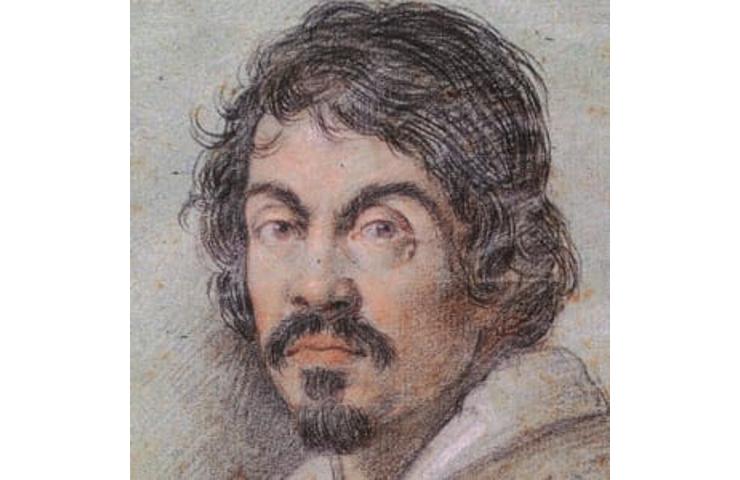No products in the cart.

Painter (c. 1571–1610)
Caravaggio, or Michelangelo Merisi, was an Italian painter who is considered one of the fathers of modern painting.
Synopsis
Caravaggio was born as Michelangelo Merisi in Italy around 1571. He was orphaned at age 11 and apprenticed with a painter in Milan. He moved to Rome, where his work became popular for the tenebrism technique he used, which used shadow to emphasize lighter areas. His career, however, was short-lived. Caravaggio killed a man during a brawl and fled Rome. He died not long after, on July 18, 1610.
Early Years
Caravaggio, whose fiery masterpieces included “The Death of the Virgin” and “David with the Head of Goliath,” and who inspired generations of artists, was born as Michelangelo Merisi da Caravaggio in 1571 in Italy. The world he arrived in was violent and, at times, unstable. His birth came just a week before the Battle of Lepanto, a bloody conflict in which Turkish invaders were driven out of Christendom.
Not much is known about Caravaggio’s early family life. His father, Fermo Merisi, was the steward and architect of the marquis of Caravaggio. When Caravaggio was six, the bubonic plague rolled through his life, killing almost everyone in his family, including his father.
According to writer Andrew Graham-Dixon, author of the 2011 biography “Caravaggio: A Life Sacred and Profane,” the artist’s troubled adult years stemmed directly from that traumatic loss of his family. “He almost seems bound to transgress,” Dixon writes. “It’s almost like he cannot avoid transgressing. As soon as he’s welcomed by authority, welcomed by the pope, welcomed by the Knights of Malta, he has to do something to screw it up. It’s almost like a fatal flaw.”
Orphaned, Caravaggio took to the streets and fell in with a group of “painters and swordsmen who lived by the motto nec spe, nec metu, ‘without hope, without fear,'” wrote an earlier biographer.
At the age of 11, Caravaggio relocated to Milan and began apprenticing with the painter Simone Peterzano. In his late teens, perhaps as early as 1588, a penniless Caravaggio moved to Rome. There, to keep himself fed, Caravaggio found work assisting other painters, many of them far less talented than he. But as instability defined his existence, Caravaggio jumped from one job to the next.
Sometime around 1595, Caravaggio struck out on his own and started selling his paintings through a dealer. His work soon caught the attention of Cardinal Francesco del Monte, who adored Caravaggio’s paintings and quickly set him up in his own house, with room, board and a pension.
A prolific painter, Caravaggio was known to work quickly, often starting and completing a painting in just two weeks. By the time he had come under the influence of del Monte, Caravaggio already had 40 works to his name. The lineup included “Boy with a Basket of Fruit,” “The Young Bacchus” and “The Music Party.”
Much of Caravaggio’s early work featured chubby, pretty young boys done up as angels or lutenists or his favorite saint, John the Baptist. Many of the boys in the paintings are naked or loosely clothed. Caravaggio’s only known assistant was a boy named Cecco, who appears in a number of Caravaggio’s works and who may have also been his lover.
Widening Appeal
In 1597, Caravaggio was awarded the commission for the decoration of the Contarelli Chapel in the Church of San Luigi dei Francesi in Rome. It was an important and daunting assignment, charging the 26-year-old painter with the task of creating three large paintings depicting separate scenes from St. Matthew’s life.
The three resulting works, “St. Matthew and the Angel,” “The Calling of St. Matthew,” and “The Martyrdom of St. Matthew,” were finished in 1601, and together showed Caravaggio’s remarkable range as an artist.
But these works also provoked much consternation from the church and public alike. In his execution of the work, Caravaggio eschewed the traditional worshipful depictions of the saints and presented St. Matthew in a far more realistic light. His first version of “St. Matthew and the Angel” caused so much angst among his patrons that he had to redo it.
For Caravaggio, however, the commission provided an exciting new direction for his painting, one in which he could lift traditional religious scenes and cast them with his own dark interpretation. His biblical scenes became populated with the prostitutes, beggars and thieves whom he had encountered on the streets of Rome.
In addition to some financial relief, the Contarelli Chapel commission also provided Caravaggio a wealth of exposure and work. His paintings from the next few years included “The Crucifixion of St. Peter,” “The Conversion of St. Paul,” “The Deposition of Christ” and his famous “Death of the Virgin.” The latter, with its depiction of the Virgin Mary with a swollen belly and bared legs, packed so much of Caravaggio’s style that it was turned away by the Carmelites and eventually landed in the hands of the Duke of Mantua.
Troubled Life
Controversy, though, only fueled Caravaggio’s success. And as that success grew, so did the painter’s own personal turmoil. He could be a violent man, with drastic mood swings and a love for drinking and gambling.
A frequent fighter, Caravaggio eventually served a short prison sentence in 1603 following another painter’s complaint that Caravaggio had attacked him. But the next few years only saw Caravaggio’s temper becoming hotter. His litany of assaults included throwing a plate of artichokes at a waiter in 1604, and attacking Roman guards with stones in 1605. Wrote one observer: “After a fortnight’s work he will swagger about for a month or two with a sword at his side and a servant following him, from one ballcourt to the next, ever ready to engage in a fight or an argument.”
His violence finally erupted with force in 1606, when he killed a well-known Roman pimp named Ranuccio Tomassoni. Historians have long speculated about what was at the root of the crime. Some have suggested that it was over an unpaid debt, while others have claimed that it was the result of an argument over a game of tennis. More recently, historians, including Andrew Graham-Dixon, have pointed to Caravaggio’s lust for Tomassoni’s wife, Lavinia.
On The Run
Immediately following the murder, Caravaggio fled Rome and sought refuge in a host of other locations: Naples, Malta and Sicily, among others. But even as he fled from punishment for his crime, fame followed Caravaggio. In Malta, he was received into the Order of Malta as a Knight of Justice, an award that he was soon stripped of when the Order learned of the crime he had committed.
However, even as he fled, Caravaggio continued to work. In Naples, he painted “Madonna of the Rosary” for a fellow painter, and later “The Seven Works of Mercy” for the church of Pio Chapel of Monte della Misericordia.
In Malta, he created “Beheading of St. John the Baptist” for the cathedral in Valletta. In Messina, his work included “The Resurrection of Lazarus” and “The Adoration of the Shepherds,” while in Palermo he painted the “Adoration with St. Francis and St. Lawrence.”
One of Caravaggio’s more shocking paintings from this period is “Resurrection,” in which the painter revealed a less saintly, more bedraggled Jesus Christ escaping from his tomb in the middle of the night. This scene was no doubt inspired by events in Caravaggio’s own life. By this time, Caravaggio had become a nervous wreck, always on the run and in constant fear for his life, so much so that he slept with his clothes on and with a dagger at his side.
Later Years
The murder that Caravaggio committed in 1606 was not the end of his violence. In July 1608, he attacked Fra Giovanni Rodomonte Roero, one of the most senior knights in the Order of St. John in Malta. Caravaggio was arrested and jailed for the assault but managed to escape just one month later.
According to Andrew Graham-Dixon’s research, Roero did not put the attack behind him. In 1609, he followed Caravaggio to Naples and assaulted the painter outside a tavern, disfiguring his face.
The attack had a profound impact on Caravaggio’s mental and physical state. His vision and brushwork suffered from the assault, as evidenced by two of his later paintings, “The Martyrdom of Saint Ursula” and “The Denial of Saint Peter.”
In order to avoid punishment for murder, Caravaggio’s only salvation could come from the pope, who had the power to pardon him. Most likely informed that friends were working on his behalf to secure his pardon, in 1610 Caravaggio began to make his way back to Rome. Sailing from Naples, he was arrested in Palo, where his boat had made a stop. Upon his release, he resumed his journey and eventually arrived at Port’Ercole, where he died just a few days later, on July 18, 1610.
For many years the exact cause of Caravaggio’s death had been shrouded in mystery. But in 2010, a team of scientists who studied Caravaggio’s remains discovered that his bones contained high levels of lead—levels high enough, they suspect, to have driven the painter mad. Lead poisoning is also suspected of having killed Francisco Goya and Vincent van Gogh.
Influence
Even though Caravaggio was shunned after his death, he eventually came to be recognized as one of the founding fathers of modern painting. His work greatly influenced so many future masters, from Diego Velazquez to Rembrandt. In Rome, in 2010, an exhibition of his work that marked the 400th anniversary of his death attracted more than 580,000 visitors.



